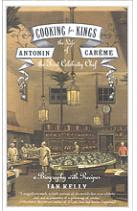 Can we talk about food? Honestly, I don’t know how our heroines aren’t big as houses–most of the lifestyle books I’ve read about the Regency suggest that butter was big, and vegetables weren’t. Plus dinners were long, drawn-out events with course upon course upon course.
Can we talk about food? Honestly, I don’t know how our heroines aren’t big as houses–most of the lifestyle books I’ve read about the Regency suggest that butter was big, and vegetables weren’t. Plus dinners were long, drawn-out events with course upon course upon course.
If I had lived during that time, I would be challenging Prinny to a weight-off.
Why am I talking about this? Because, like a lot of women, my eating is psychologically motivated. My agent is in the midst of submitting my Regency-set historical, Lessons In Love, and so far I’ve gotten three [very nicely-worded] rejections. My immediate response has been to head for the cookies. My next response has been to think about how I’m getting older (I’m 42; here I am in one of my favorite vintage dresses. It hides a lot.), the metabolism seems to be slowing, working out is hard enough without carrying extra poundage, and really, eating cookies is such a silly reaction. So I settle for a rice cake or iced coffee or something. I’ve still gained a few pounds, but at least it’s not more than a few pounds.
I’m guessing some of the more expertish of Riskies know exactly what the ladies did back then to keep from expanding like the universe–constantly. There was all that needlework, the occasional sidesaddle horseback ride, walking around the gardens, changing clothes, writing letters, etc., etc. No elliptical for those women.
I am guessing that some of you, as well as my fellow Riskies, also have “bad” reasons for eating; what do you do to stave it off? (And why does eating have to be “good” or “bad”?) What’s your favorite ‘me time’ indulgence? How do you think our heroines kept their slim, girlish figures?





